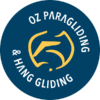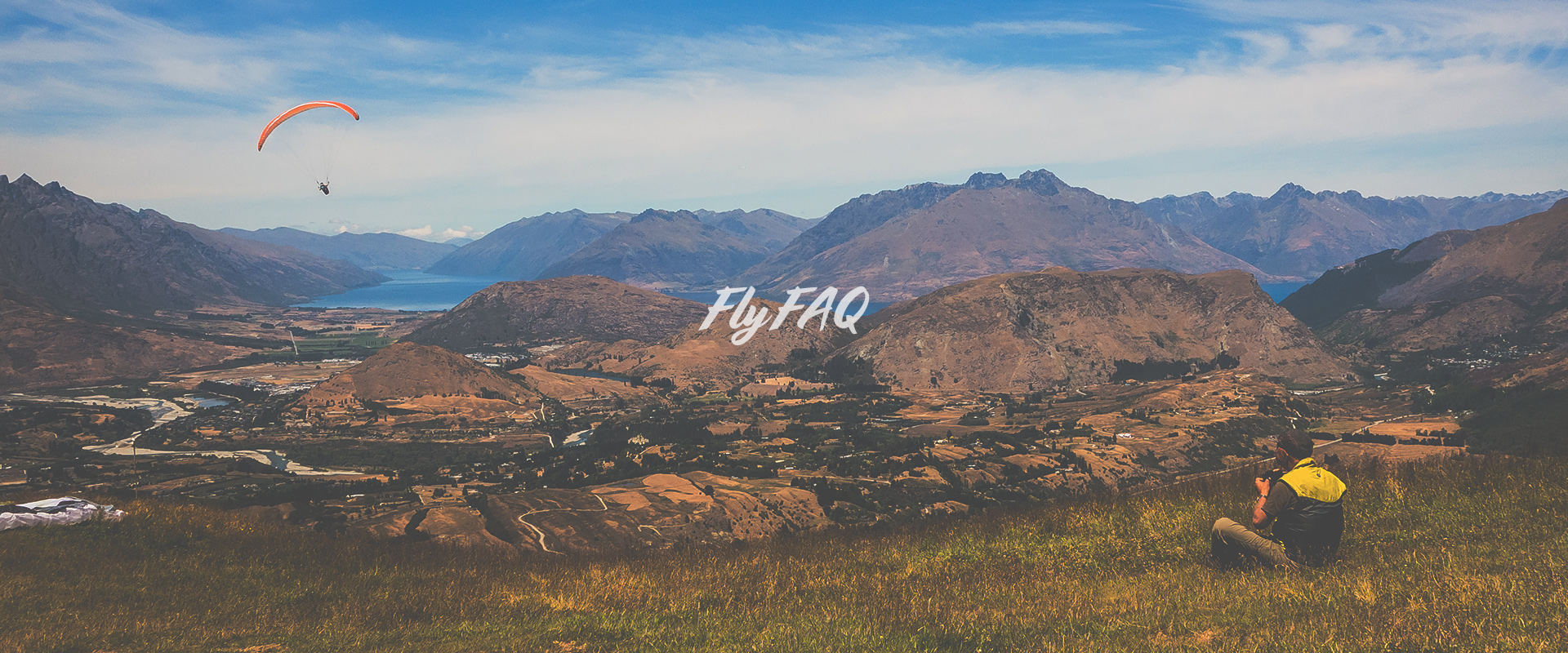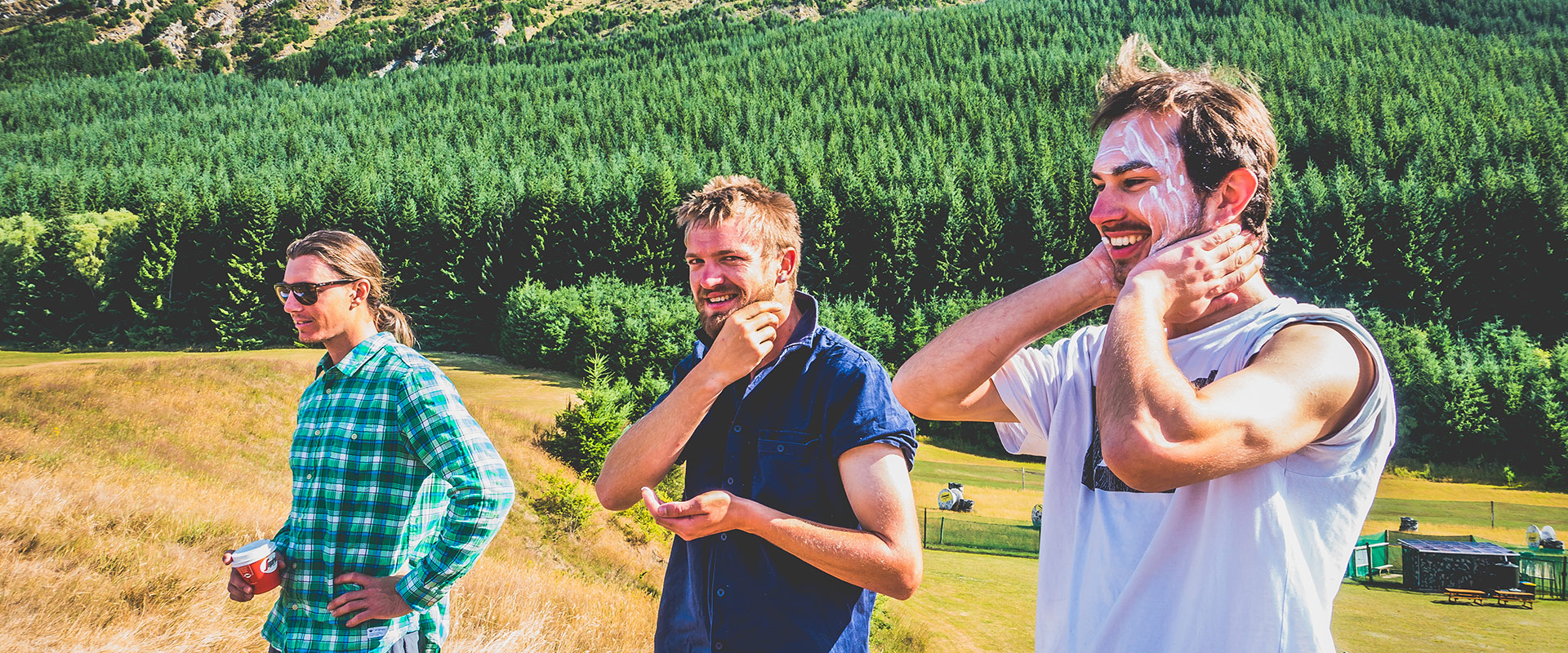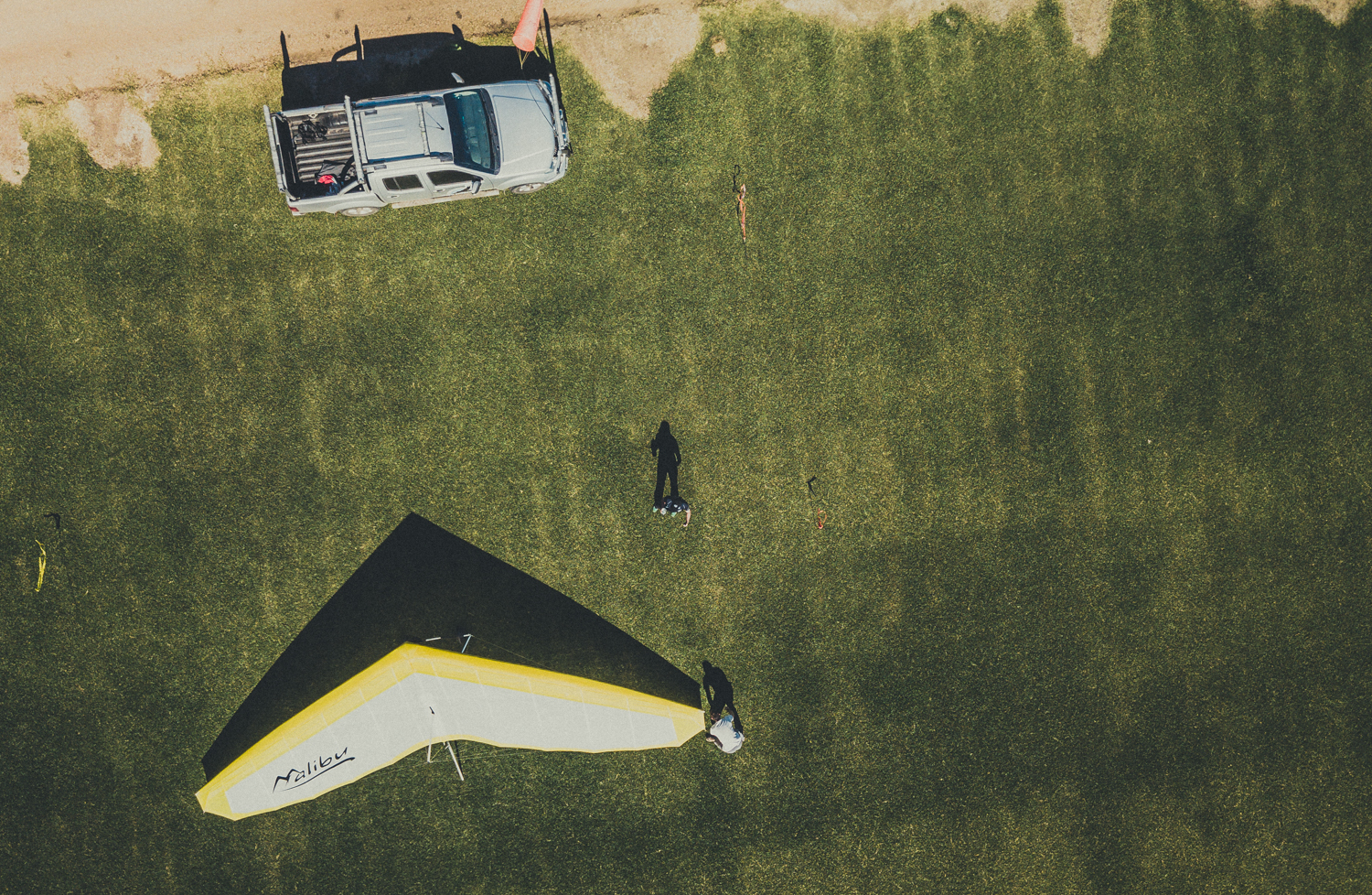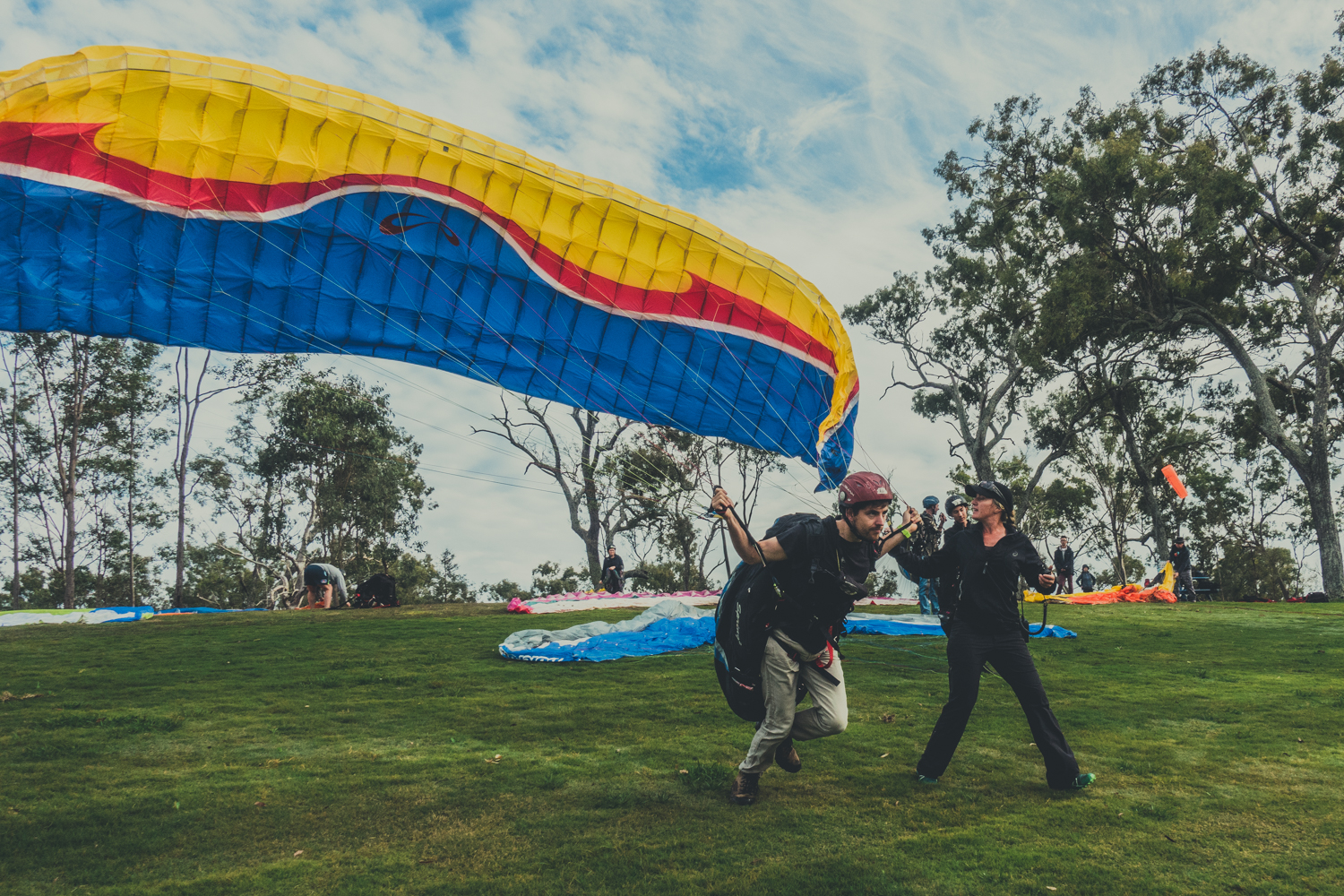Frequently Asked Flying Questions
The paraglider canopy shape is maintained only by air pressure and the pilot is suspended in a sitting or supine position.
A hang glider has a rigid frame maintaining the shape of the wing, with the pilot usually flying in a prone position. Hang gliders fly at much faster speeds than paragliders.
Please check out our calendar for the latest school schedule. While we have set dates for training, we also run courses if there is sufficient demand.
Our flight training facility is located at 224 Four Mile Lane, Boyland, Queensland 4275 – see map below.
There is no public transport available and most students drive by car. Contact us if you require transport from the airport or the nearest train station which is Nerang. We may be able to put you in contact with other students traveling from your location.
If you fly in from Brisbane airport. you can catch the public transport bus to Beaudesert and we can pick you up from the Coles supermarket.
While launching, flying and landing a paraglider or hang glider is surprisingly effortless, learning to fly them is not – it can be physically, mentally and emotionally exhausting.
While you start on gentle slopes, soon you will be flying off 30 metre and 50 metre training hills. As the saying goes ‘What goes up must come down.’
After landing at the bottom you need to carry all your gear back up to the top of the hill and do it all again. A full set of paraglider gear weighs up to 15 kilos. Hang gliders weigh even more – up to 22 kilograms PLUS gear. If you require assistance during the course – we can offer a driver to carry your gear back up to the top, at an extra cost!
Launching requires a strong core and legs to power forward – so a few daily sets of 10 sit-ups, squats and lunges in the weeks leading up to your course will definitely help. Some landings can have a fast forward component, requiring you to run off the speed – so being able to run a short sprint with your hands held above your head is beneficial.
Finally setting up a paraglider or hang glider requires a lot of squatting on the ground, and bending down so working on your flexibility is highly also recommended!
In general, the rules for holding a paragliding or hang gliding license are the same as those for holding a drivers license.
This is a link to the Queensland Transport information.
Your registration for our courses will require you to disclose for your own and our team’s safety the following:
- Medications you are currently taking that could potentially cause drowsiness like antihistamines etc?
- Physical Impairment/Disability to eyesight, past surgery, injuries, back or joint pain that impacts weight bearing, running, bending or lifting.
Yes we running team-building exercises. Learning to paraglide – even just the basics – offers a unique and memorable team bonding experience.
TEAM – Together Everyone Achieves More
Just send us an email info@ozparaglidingandhanggliding.com.au
on your proposal, numbers, dates and specific goals.
The following information is listed on the SAFA website click here.
‘The Sports Aviation Federation of Australia (SAFA) is the sporting body that administrates Hang Gliding, Paragliding and Weight Shift Microlights in Australia under regulations laid down by Civil Aviation Safety Authority (CASA).
It represents over 3500 members and their clubs providing a framework for all pure flight aviation enthusiasts to take part in the sport they love, in a safe, fun way.’
Like the regulations that govern the licensing of recreational and commercial power plane pilots, all paragliding and hang gliding pilots must be an SAFA member to fly in Australia.
We have flown passengers in tandems from 10 to 92 years of age. We have trained students from 14 to well into their 70s.
A student aged 14 to 17 must have the form signed by a guardian. The minimum age a pilot license can be issued is 16 years of age.
As long as students have good general fitness and good flexibility, many people continue to fly well into their senior years.
We generally recommend people with concerns about age or fitness take up paragliding first. We recommend this, simply because a paraglider weighs a lot less than a hang glider. We work with all our students individually and help them progress at their own pace.
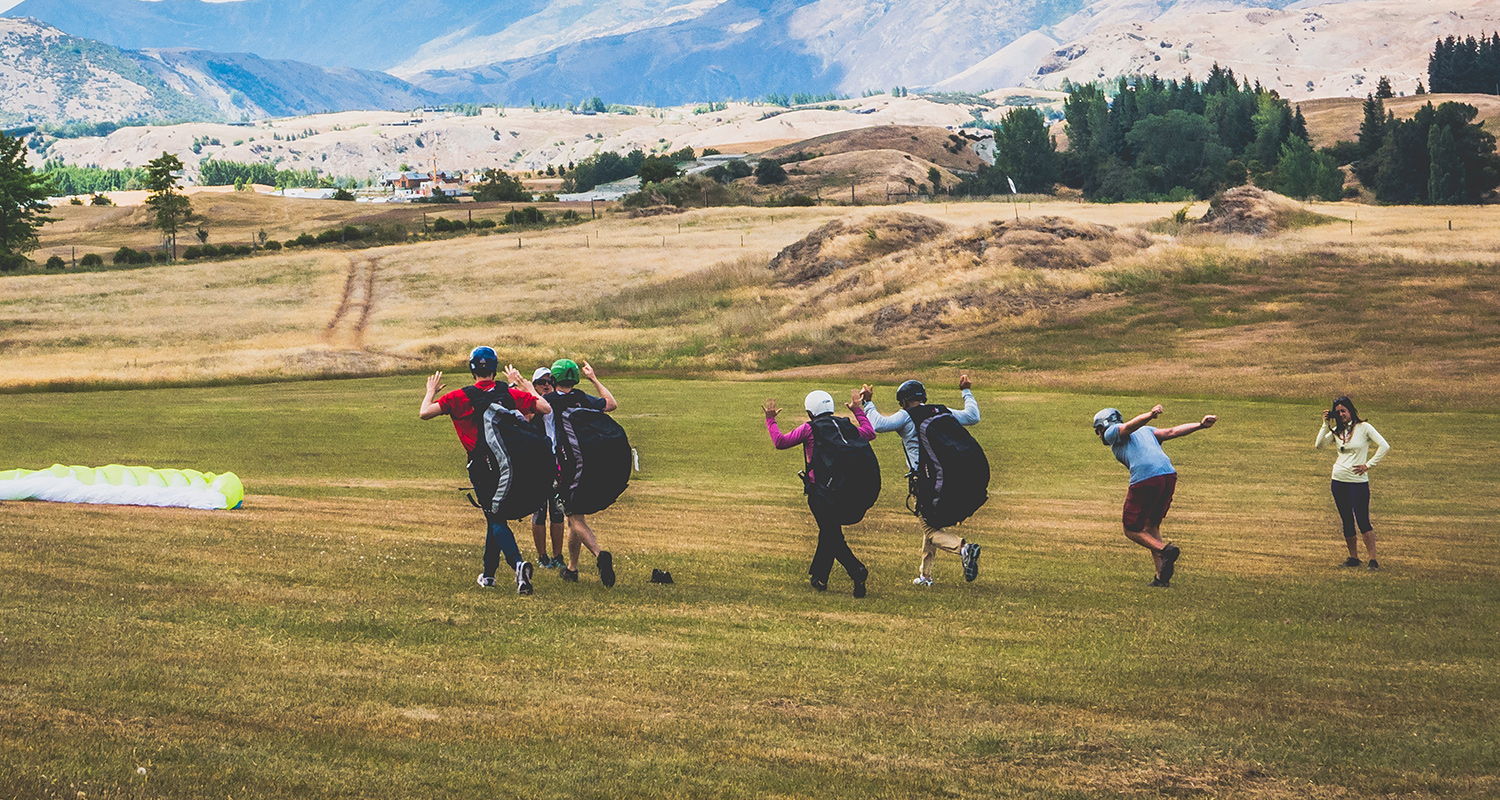
Learning to fly is in principle similar to learning how to drive a car! Provided you listen to your instructors, obey the rules, exercise caution, strive to understand prevailing conditions and keep a good lookout for others and anticipate their movements – you should be fine.
Flying is riskier because it adds a couple more dimensions – namely height and susceptibility to dynamically changing weather conditions. Your training is focussed on learning to understand and mitigate risks through observation and following a simple set of procedures – e.g. have you done a line check; is your helmet on or are your shoelaces tied up.
Common sense prevails in this sport – if there is a howling wind – would you fly? Rule of Thumb – if you have doubts DON’T FLY!
All adventure sports carry inherent risks and paragliding is no exception.
To operate safely in any kind of aviation environment every pilot strives at all times to minimise those risks. The most important attributes to paragliding safely are pilot attitude, competent instruction and safe equipment.
The modern paraglider is a sophisticated aircraft that has been computer designed, flight-tested and certified to an international standard. Ongoing research, testing and development ensures that paragliders are sophisticated in design and very safe.
International acceptance of an Australian SAFA pilot license and permission to fly there depends on the country. There are no standard rules, so you need to check with the country you will be going to.
Unlike pilot certificates issued by a government body (the international equivalent of CASA) most hang gliding and paragliding licenses are issued by private associations.
Listed below are just some of the variations that exist between countries
– United States has no licensing requirements, or
– Austria requires you to be separately licensed by their association, even if you already have a license, and
– Germany will accept/not accept your license depending on whether you are going there to visit or to work!
The SAFA issues an internationally recognised IPPI card which is valid for acceptance in some countries. You can see a country by country breakdown here: FAI Validity
Yes. Your license means you have completed a certified course by endorsed instructions, demonstrated competency in flying skills, passed a theory exam AND be a member of the Sports Aviation Federation of Australia (SAFA).
Visiting international pilots must be sure they have SAFA Visiting Pilot Membership (VPM), before flying in Australia.
Paragliding and hang gliding is regulated by the CASA (Civil Aviation Safety Authority) under CAO 95.8. The HGFA is responsible for many regulatory functions like issuing pilot certificates, instructor accreditations, promoting the sport and safety as well as providing public liability insurance for its members. The SAFA also regulates clubs and flying sites in conjunction with state associations.
For more information on the role and responsibilities of the SAFA click here
Your student membership to the Sports Aviation Federation of Australia (SAFA) provides public liability insurance that extends to damage you cause to others while flying.
Travel and health insurance varies a good deal from provider to provider, and policy type – beware many standard insurance policies specifically exclude covering persons engaged as a pilot in paragliding or hang gliding sports. You should review your policy and seek clarification from your insurer. We strongly suggest that anyone traveling from abroad to train with us take out travel insurance that covers the activities they will be undertaking.
The Australian government has Reciprocal Health Care Agreements (RCHA) with a few foreign countries that allow access to some public health benefits. At the time we are writing this, the Australian government has RCHA’s with the United Kingdom, the Republic of Ireland, New Zealand, Sweden, the Netherlands, Finland, Belgium, Norway, Slovenia, Malta and Italy.
- Sports clothes – long sleeves are good for sun protection and wearing layers to keep you warm on cold mornings and then can peel off during the hotter parts of the day
- Sports bag to hold wallet, mobile phone, car keys you’d normally carry in your pockets
- Warm wind-resistant jacket
- Towel (to wipe off moisture and mud)
- Tissues
- Running or light weight, lace-up sports shoes (avoid heavy boots)
- Lunch and snacks
- Plenty of water (minimum of 2 litres)
- Sunblock
- Sunglasses and sun hat
- Spare pair of shoes (the ones you train in may be wet and muddy at the end of the day)
- Small denomination coins or notes just in case you share a car and need to contribute towards the cost of petrol
- Pens and notebook
40kg to 90kg. If you weight more you will need to talk to us.
If required the school may need you to purchase a bigger glider for you to fly in the school.
Our school only uses HGFA certified paragliders and hang gliders that are rated up to a specific weight – that includes you and all your gear – helmet, harness, UHF radio, emergency parachute and your glider – the latter weighing approximately 15 kilos.
Maximum is 90kg. If you weight more you will need to talk to us.
If required we may need a bigger glider for you to fly safely – this means you may have to purchase one from us prior to commencing a hang gliding course.
Here is a sample of Lisa giving a lesson on practical flight planning.
At the beginning of the course you will be issued with a comprehensive workbook to support your theory classes. We encourage our students to write their own notes after we have explained concepts and tested flying scenarios. These are fun interactive sessions. During our 9-day courses when the weather prevents us from training, we can use this time productively progressing through theory in preparation for your exam and to put into practical use the next time you fly.
To gain your pilot’s certificate our governing body the Hang Gliding Federation of Australia (HGFA) requires all pilots towards the end of their course to demonstrate practical flying skills and to pass a theory exam (minimum pass on Part A is 100% and Part B 80%) covering all aspects of our sport – rules of the air, weather, aerodynamics, definitions and common terminology just to name a few topic areas.
Listed below are some sample questions:
- What is the minimum height a paraglider may be flown over any city, town or populous area?
- What is the minimum distance a paraglider may be flown from spectators?
- What are the rules of the air for two gliders approaching head on in clear air?
- What technique is used to recover from a wing tip tuck?
- How would you recover from a full stall?
- What are pilots’ responsibility regarding right off way?
- What are the priorities of first aid?
- Define parasitic drag and induced drag?
- Define Angle of Attack?
- What are the units of measurement used in navigation for speed, distance, direction and height?
- What are the dangers in flying in lee side rotor?
- When can a paraglider be legally flown?
- When is katabatic airflow likely to occur?
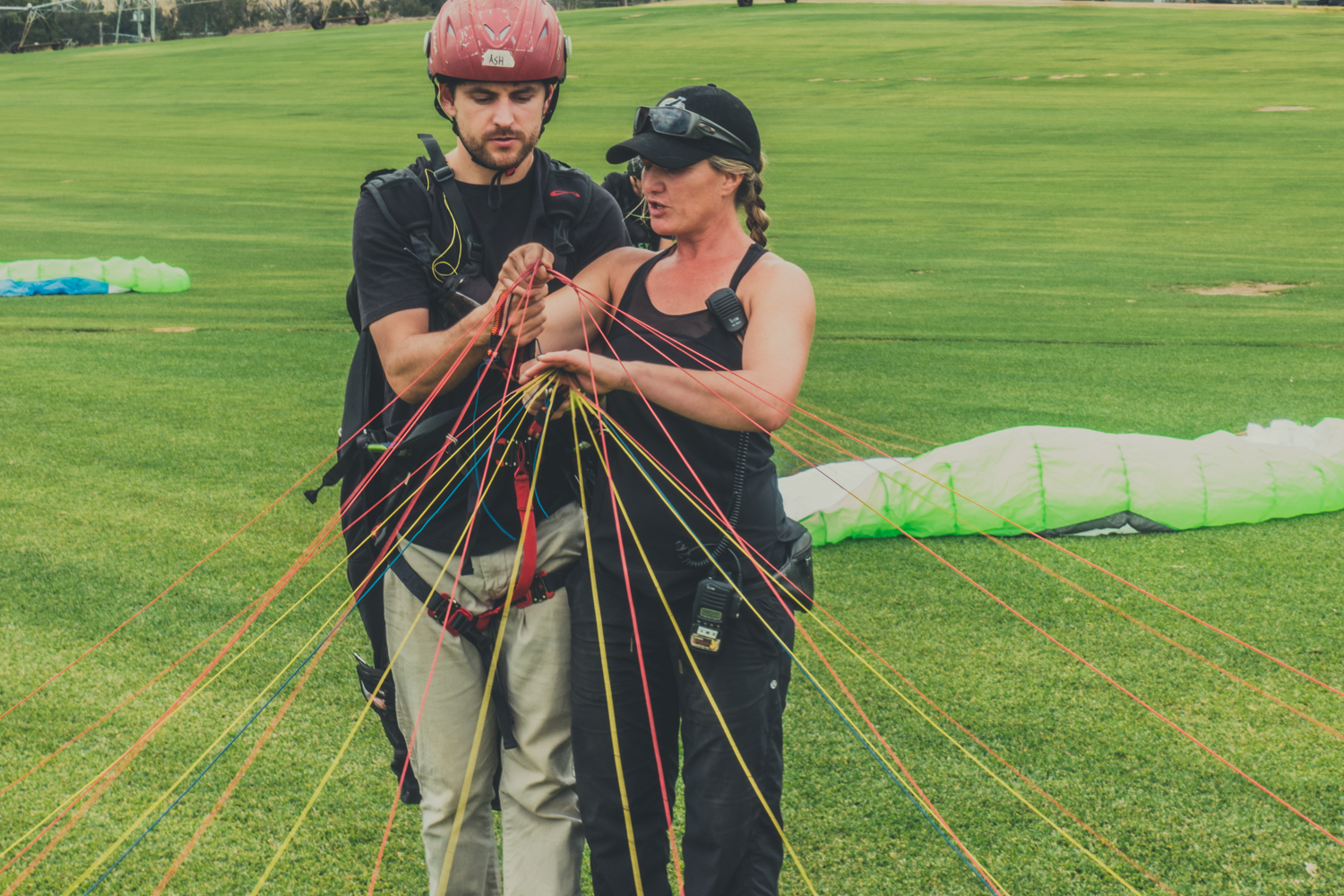
The majority of our students complete their courses and sit their theory exams within the allocated 9-days.
However, weather plays a big role in all forms of aviation, especially free flight. For the safety of students we only teach within a fairly narrow band of calm consistent weather.
Our school is one of Australia’s leading innovators of paragliding and hang gliding teaching methods. Our purpose-built flight park has a dedicated on-site training facility with multi-aspect small and medium training hills, a large ground handling area, uses a winch to tow up gliders for low-wind days, and speed wings for ground handling in higher wind conditions (which would normally suspend normal paraglider training activities). Hang gliders can tolerate higher winds.
There are still some conditions that are simply not flyable. When you plan your trip, we suggest you allow some additional time in Canungra in case you experience adverse weather conditions.
At Canungra Sky Sports we understand and strive to accommodate people who learn at different rates. Some people take longer to develop the required skills. All of our license courses are competency based.
Depending on individual circumstances if you complete the number of days allocated for your course (depending on the weather they may not be consecutive) and you still do not have a license, an additional charge at a daily rate may apply.
For your own safety we will not sign you off until you are ready and have fulfilled all the HGFA requirements for pilot certification.
All of the equipment we use for training is state-of-the-art and appropriately certified for use in the school. You will be shown how to maintain it in pristine condition, clean and safe for flying – as though you owned it yourself.
For paragliding, most of the gear we use is manufactured by Sol paragliders. The gliders are EN-A, LTF-1 rated (the ratings with the most passive safety).
For hang gliding we use Moyes Malibu and Airborne – Fun 19o Floaters.
Yes, but you will need to work around when different stages of course are being held that are appropriate to your competency levels. It may also take you longer and cost you more.
Our flight park is located at 224 Four Mile Lane Boyland Queensland – just 15 minutes from the nearest towns of Canungra and Beaudesert.
The Sports Aviation Federation of Australia (SAFA), is a not for profit organization. The Australian Civil Aviation Safety Authority (CASA) has delegated authority to regulate some aspects of paragliding and hang gliding to the SAFA.
Membership in the SAFA is a legal requirement for training, being granted a license and holding a license. You can find out more about the SAFA here.
In Australia, hang gliders and paragliders are limited to a maximum altitude of 10,000 feet above sea level.
There may be additional limitations based on airspace restrictions or the requirements to be licensed to use and able to use an airband (VHF) radio.
The Oz Sky Ranch is home to our school. Over the last few years, we have been developing an all-in-one flight park specifically to meet the needs of a busy paragliding and hang gliding school. This maximises your time learning rather than time wasted driving to different training sites.
We have on-site accommodation for our students and tandem passengers.
Our initial training is on the soft beautifully groomed and gently sloping hills of the Oz Sky Ranch it is based on a turf farm that enables us to take advantage of any wind direction.
We have a very large wide open flat area suitable for ground training paragliders. When required this area can also be used for towing by winch (paragliders and hang gliders) and for aerotowing hang gliders with an ultralight Dragon Fly.
Within walking distance of the classroom is Mt John a low 30-meter training hill where most students will experience the thrill of their first flights.
For high flights, we are close to the launch and landing (bomb-out) sites of Mt Tamborine, Beechmont, and Hinchcliff.
These are acronyms and a convenient shorter way of referring to different aviation sports
HG Hang Gliding
PG Paragliding
These are acronyms and a convenient shorter way of referring to different levels of training in hang gliding:
HG1 is the first level of training in a hang gliding course, it comprises of ground training school and low flights.
HG2 is undertaken after the completion of HG1, and means students are able to undertake high flights such as from Mt Tamborine.
Yes, at Canungra Sky Sports you will learn on what we call an EN-A paraglider.
EN-A certified paragliders are extremely forgiving and show exceptional resistance to deviation from normal flight. They are designed for ALL PILOTS, and suitable for any level of training.
Just in case you were wondering what this certification means, here is some background. For historical reasons, there are two certification schemes for paragliders.
The EN, or European Norm, standards are issued European Committee for Standardization and are implemented by a number of certified testing companies. The LTF standards (formerly DHV) are issued by German Hang Gliding Association and are implemented by certified testing companies.
In practice, most manufacturers pick testing companies that issue both certifications.
Paragliders are certified on a sliding scale (EN A to D, LTF 1 to 3). All certified gliders must meet airworthiness standards. The lower ratings (EN A or LTF 1) represent gliders that demonstrate stronger passive safety characteristics. They recover from abnormal flight conditions quickly and with little or no pilot input.
Different size gliders are certified for different weight ranges, which is why we ask you about your weight.
There are also airworthiness certifications for helmets, harnesses and recovery systems (reserve parachutes). All equipment we supply for flying certified and regularly inspected for safety.
For ground training in high winds, we use speedwings. The standards for certification for speedwings are still emerging and speedwings are not used for training flights.
Typically outfitting a new paragliding pilot would cost between $4,500 and $6,000 with hang gliding substantially more $8,000+.
At the completion of your training, you are eligible for a coupon that entitles you to a substantial discount on the purchase price of your first set of equipment.
Canungra Sky Sports usually has some sets of good quality ex school and ex student gear to sell – just inquire to find out what we currently have in stock.
For your safety you need to use paragliding equipment that has been certified by agencies independent of the manufacturing organization. You should also be cautious of buying second-hand equipment, make sure you get a thorough profile of its usage history or have someone knowledgable check it out.
In general, reputable manufacturers will make their certification documents available via their websites. Some kinds of equipment are certified on a pass-fail basis.
Listed below is information on each gear’s certification profile:
- Helmets are certified to EN 966 standard (helmets for air sports). The testing consists of loading them up with 6 kg of weights (average weight of a human head) and dropping them repeatedly on an anvil. There has been some criticism of the EN 966 standards, and some pilots use helmets certified to both the EN 966 and the more stringent EN 1077 (downhill skiing). The important elements in picking a helmet are to make sure it is certified, it is secure and that you replace it after any damage or hard impact event.
- Reserves (aka Recovery Systems) – Reserves are parachutes that can give you a second chance if your primary glider gets into a situation where you cannot recover it. Reserves are certified to the EN 12491 standard. The certification tests the speed of opening, the opening shock, the strength of the deployment system, the strength of the attachment system, the speed of descent and the stability of descent. Reserves are certified for specific weight ranges. It is important to pick a reserve certified for the right weight.
- Harnesses – Harnesses are certified to the EN 1651 and/or the LTF 91/09 standards. Both standards require tests of the strength and structural integrity of the harness. Only the LTF standard requires testing of the back protector system.
Read the FAQ answer on paraglider certification to understand the ratings below:
Rating |
Flying Characteristics |
Pilot Characteristics |
|---|---|---|
| A | Paragliders with a maximum level of passive safety. EN-A Certified Paragliders are extremely forgiving and show exceptional resistance to deviation from normal flight. | EN-A Certified Paragliders are designed for ALL PILOTS, and suitable for any level of training. These are great for pilots with less than 1 year of flight experience, or for those who fly less than twice a month (25 hours a year). |
| B | EN-B Certified Paragliders display good passive-safety and forgiving flight characteristics.The glider must have some resistance to deviation from normal flight. |
NOTE: Pilots should have experienced AT LEAST 30 hours of flight time in various flight conditions. At least 10 of those hours being in thermic conditions. EN-B Certified Paragliders are commonly own by pilots with advanced “ratings” or “certifications,” and for those who have no less than 50 hours per year (3-4 times per month). |
| C | EN-C Certified Paragliders possess a moderate level of passive safety.These gliders can potentially display dynamic reactions to turbulence or pilot errors.
Precise “active piloting” or input may be required for recovery. |
EN-C Certified Paragliders are designed for intermediate pilots who possess good “active piloting” skills and are quite familiar with recovery techniques.The pilot must fully understand the implications of flying a glider with reduced passive safety. Pilots should possess an advanced rating or certification, and have logged HUNDREDS of flight hours in ALL conditions (especially thermic). An “SIV” or “Advanced Maneuvers” Clinic should be completed by pilots flying EN-C Paragliders.
Recommended for those who fly at least 10 hours per month (2 times per week), and for those who are comfortable handling large asymmetric collapses. |
There are a few things you should keep in mind. In each of these categories, there is a range of paragliders.
Flying a low-B is not at all like flying a high-B. You need guidance from professional instructors. In our experience, very few pilots will be ready for anything other than an A at the end of training. Flying even a low B would probably constrain them to benign conditions.
Many recreational pilots fly A-wings for years. Progression to higher wings is often a marketing tactic. You should fly a wing you are comfortable with.
It is something you need to think about very carefully. The advantage of a used wing is that it is cheaper than a new one.
The things you need to think about are:
1. Paragliders have a limited life. We often talk about hours flown, but the real constraint is hours exposed to UV. That is why you will see pilots get their wing out of the sun when they are not using it. For many paragliders, the useful life is about 300 hours. Since there are no aircraft logbooks, you really cannot tell reliably how many hours they have flown or how many hours someone has let them sit in the sun. There are other components that deteriorate over time. For instance, lines stretch. So, if you get a great deal on a glider that spent 25 hours flying and 75 hours left out in the sun waiting to fly, about a third of the original value is already gone.
2. Australia has no legal requirement for periodic inspections of gliders. For new gliders that is not an issue, since they just had factory and dealer inspections. For used paragliders, it is really imprudent–at least we think so–to launch in the air on a glider you cannot know the history of without a full inspection and porosity test. A full inspection and porosity test will generally cost about $300. You may also want a test flight (generally about $150).
3. There are potential dangers to paragliders that no inspection will uncover. For instance, if a paraglider every landed in saltwater, there could be salt crystals dried in the lines that could result in a line breaking just when it is holding you up.
4. Paragliding technology evolves. Your used glider may not have the latest technology.
The choice is yours, but we find many cases where the economics of a used glider just does not add up.
As an example, we recently saw for sale a 3-year-old glider with a claimed 5 hours flight. The price new would be $4,800, the price it was offered at was $3,600. Was it a good buy? Here is how I would do the math, you may do it differently
Category |
Calculation |
|---|---|
| UV deterioration | 5 hours is not much airtime, but the key is UV exposure time. There is no way to tell, the glider could have been used for ground handling, it could have been left in the sun while waiting to fly. The ve hours could have been accidentally understated. Let’s call it 40 hours of sun exposure or about 15% of the value, so deduct about $720 dollars. |
| Inspection / Flight test | This glider has some kind of weird history. I would want both. So deduct about $450 dollars. |
| Hidden Dangers | No way to really to account for |
| Technology | This is the current manufacturers model |
| Adjusted Cost | $4,800 -$720 – $450 = $3,630 |
| Net savings for buying used | $30 |
My feeling is that I am taking a risk and not really saving that much.
In this case, I would pass. You might choose differently.
Not sure? Why not do an instructional tandem; even better come to our one or two day introductory courses in paragliding or hang gliding?
This will give you a realistic understanding of what your training involves and provide you with the pre-requisite practical fundamentals of a full course.
You are eligible for a significant discount if you decide to go on and complete a full 9-day license course.
Towing is effortless launching! Instead of using your own running to generate the wind beneath your glider wing, you have a line attached to your harness and you get pulled into the air.
There are two forms of towing. Ground towing involves using a winch to pull you up into the ground. We offer training in ground towing to hang gliders and paragliders.
You need an extra endorsement via the HGFA to do this. Aerotowing only applies to hang gliders. You lay on a wheeled dolly and a light aircraft pulls you into the sky. We also offer training on this endorsement.
A specially designed tow plane called a “tug” tows a tandem hang glider into the air. On the ground the hang glider with tandem pilot and passenger laying in a prone position rests on a trolley with wheels. As the tug moves forward it creates the airflow that enables the hang glider to gently lift off the trolley while still being attached by a tow line.
Aero–towing is superior to hill launching in that it can take the hang glider as high as desired and can release it at any point.
The Mt Tamborine launch is located at 92/118 Tamborine Mountain Rd, North Tamborine QLD 4272.
The Beechmont launch is managed by the Canungra Hang Gliding Club. It is located on Beechmont Road, Beechmont next to Rosin’s Lookout. It is opposite The Flying Bean Cafe a popular scenic spot for tourists. Click here for a Google maps link.
Tandem Flights
Wearing clothes and shoes suitable for some physical activity is required:
- Sturdy shoes or trekking sandals that you would go for a brisk walk, jog or play sport in. Preferably with a closed toe to better protect your feet.
- A warm top. Even if the day is hot it is cooler when flying around in the sea breeze. On a cold day it can be very chilly, so rug up.
- Mid thigh shorts, long pants or tights are best as you are secured by harness straps that pass between your legs.
- Bring sunglasses. If they are loose you may want to secure them before flight.
- Sunscreen, hat and water – sometimes we have to patiently wait for the conditions to be just right.
- Lake and swimming hole on-site. You may like to have your swimmers and towel for a swim. We also rent out kayaks and stand up paddleboards,
You must be between 20kg to 100kg for tandem flights.
This may vary depending on your tandem pilot’s weight. Please email us if you are unsure we can accommodate your weight.
The main differences between paragliding and hang gliding are launching method, harness position and flying speed.
On paraglider tandems we use a foot (running) launch – you the passenger become part of the mechanical engine providing the forward power to enable your paraglider to become airborne. This requires passengers to have a reasonable level of fitness, mobility and flexibility. The height of a paraglider tandem depends on both the height of the launch site and if there are any thermals (columns of air moving up) on the day. Tandem pilot and passengers are seated in their respective harnesses – feels like a comfortable sofa. Paragliders travel much slower through the air than hang gliders.
With hang gliders we can use a foot launch, but we also use aero towing – an ultralight aircraft called a Dragonfly is connected to a hang glider resting on a wheeled trolley. As the hang glider is pulled forward the airflow enables the hang glider to lift up off its trolley and become airborne. The height of release from the aero tow plus any thermals present determine to how high you can go. Pilot and passenger lie prone in their harnesses. Hang gliders travel through the air much faster than paragliders, which makes them a more exciting mode of free flying – suitable for adrenalin junkies!
No you don’t need to be fit. You will take off on wheels and land in the same place on wheels.
There is no need to walk or run to launch or landing on a hang gliding tandem. Your pilot will do it all for you. Just relax and let your instructor show you how to fly.
If you have any walking or disabilities, Tandem hang gliding is the way to go. It is also great as your friends and family can see you taking off and then landing in the same place.
Being a passenger is not physically demanding. While flying you sit back and relax. During the launch phase, you may be asked to jog a few steps at take-off and/or landing. Typically if someone can walk up and down a flight of stairs or climb a small ladder they are able to be a tandem passenger. If you have a past or existing injury or weakness that may be aggravated by a sudden change of pace or direction while walking or jogging then paragliding is best avoided. As with most physical activity if you have a joint or muscular problem it may be aggravated by a tandem flight.
Then we would recommend going tandem hang gliding, where you don’t need to walk or run on take off. you will take off and land on wheels.
Tandem hang gliding flights will last between 15 to 20 minutes.
Tandem paragliding flights can be anywhere from 8 to 20 minutes depending on the time of day and the conditions.
This all depends on the day. Thermals and uplift at the time of your tandem.
Many people challenged by many types of physical and mental disabilities can still enjoy the freedom of a tandem flight experience. It really depends on the nature of the disability. We are keen to share our passion for flight with anyone who feels likewise. Usually, the person with the disability and/or their carer will know if a tandem flight is possible and we are happy to chat through the possibilities.
We recommend anyone with a disability to pick tandem hang gliding over tandem paragliding. We can take-off and land on wheels on an aero tow tandem hang gliding flight.
Yes. We offer the special person you nominate a unique gift and what is often described by past clients as a ‘once-in-a-lifetime’ experience. You can add a special message.
Gift vouchers are issued with a unique number that you quote when booking. We will be in touch to confirm dates and if the weather is suitable. Vouchers are redeemable for 12 months from date of issue.
Paragliding requires a certain strength and direction of wind to enjoy a safe flight. Of course we must fly during daylight and we cannot fly in the rain. We make every effort to forecast weather in advance so that you and your pilot only travel to launch if there is a good chance of flying. However, the weather is unpredictable and full of surprises. If the booked time is not suitable for flying we simply make arrangements for another day that does suit. Many people are lucky and their preferred day is rewarded with a great flight. Others may require two or three different booking times to finally get airborne. We will communicate with each other the day before and/or the morning of the flight to confirm the weather and the likelihood of flying.
For safety reasons, NO passenger video or cameras are to be taken on tandem flights. Some of our tandem pilots will have a GoPro available on the day and for an extra fee can arrange for some video or photos while in the air. The current rate for video with photos is $80 (Australian dollars).
Participating as a pilot or tandem passenger in hang gliding and paragliding like any other action or adventure sport has inherent risks. You will be asked to read, complete and sign a form provided by the Sports Aviation Federation of Australia – that outlines the obvious risks of paragliding and hang gliding, informs you of the potential for accident or injury and requiring you to assume the risks involved. The only insurance coverage is third party insurance covering other people and property, not the tandem pilot or the passenger. All personal insurance such as medical, income protection, disability and life insurance are the sole responsibility of the individual.
Accommodation
We have on-site accommodation for student and tandem passengers available on-site at the Oz Sky Ranch flight park. Please email us on info@ozparaglidingandhanggliding.com.au for accommodation options, pricing and availability.
You will be working hard on flying days. Many of these days have early starts or late finishes. You really want to stay close by and avoid the long drive to and from home every day.
The Oz Sky Ranch offers a number of different accommodation options on-site including farm-stay. See photos of our site on our Gallery page. We a lovely kitchen and dining area – a great place to hang out and talk over the days learning and flying adventures.
Send us an email on info@ozparaglidingandhanggliding.com.au for information on accommodation options, pricing and availability.
No camping at the Oz Sky Ranch. Please email for more info on student accommodation. info@ozparaglidingandhanggliding.com.au
Payments
We accept bank deposits as well as cash payments on the day.
Account name: Oz Paragliding & Hang gliding
BSB number: 064 400
Account number: 1032 6492
We are unable to process debit or credit cards such as Visa, MasterCard or American Express. Our preference is cash or bank deposit
Account name: Oz Paragliding & Hang gliding
BSB number: 064 400
Account number: 1032 6492
Please note we are working on an online booking form. So soon you can pay by card online.
We take bank deposit and also cash payments on the day. We do not accepted Visas or debit cards. As we may not have internet on site some days.
Account name: Oz Paragliding & Hang gliding
BSB number: 064 400
Account number: 1032 6492
We offer gift cards for a number of our products that can be customise with a message of your choice.
Just quote the unique code on your gift card when you book any paragliding or hang gliding course or tandem. The only condition is that the service must be used within 12 months of the issue date.
Be advised that many of our students started their flying adventures with a thoughtful gift from a family member or friend.
Yes you can pay by the day. It is a higher rate and be a little more expensive than part or a single course payments.
Payment by this method requires your account balance to always be in credit.

